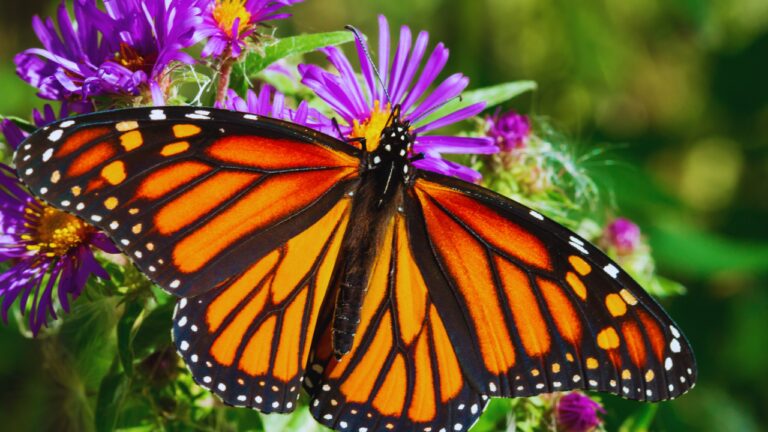The monarch butterfly is one of the most fascinating creatures in the world because of its migration pattern. This butterfly is equipped with light and temperature sensors in its brain and a magnetic compass, which facilitate its winter migration each year from the United States and Canada where it breeds to the forests of central Mexico to hibernate. The butterfly has an antenna that recognizes the time of day and the position of the sun in the sky. It flies between 2,900 and 4,500 kilometers to find the right climatic conditions for hibernation, from early November to mid-March.
Known to scientists as Danaus plexippuswhich means “sleeping transformation,” these small butterflies have a wingspan of 10 cm. Males have orange wings with black veins and white spots on the edges. Males are slightly larger than females. Monarchs are known to lay their eggs on milkweed, which is the caterpillars’ only food source. The milkweed they consume in the larval stage is stored in their bodies, which is toxic and can cause their predators to vomit, and in rare cases, die. Adult butterflies have a life cycle of only 4 to 5 weeks.
Monarch butterflies live in Mexico’s oyamel fir forest. When they arrive, these monarchs gather in sheltered areas where they huddle together on trees to hibernate. While researchers have discovered much about their migratory habits, the question that still intrigues them is how these butterflies find these particular oyamel firs.
The forests of the migrating monarchs are protected in the Monarch Butterfly Biosphere Reserve, a UNESCO World Heritage Site. Unfortunately, these butterflies are threatened by the heavy use of pesticides and climate change. According to a report, the number of monarch butterflies in their wintering grounds has dropped by 59%, the second lowest level since records began. Butterflies are not counted individually, but are counted by measuring the number of hectares they cover when they gather during hibernation. Mexico’s National Protected Areas Commission said that this year, the butterflies covered an area of 0.9 hectares, which is much less than last year, when it was 2.21 hectares.
Herbicide use in the United States, ongoing land development, conversion of prairie to farmland, and reduction of milkweed are some of the reasons why these little creatures have difficulty migrating to hibernate and are reducing their numbers. Although monarch numbers have fluctuated, the eastern population has seen a steady decline over the past two decades. Planting the right kind of milkweed in certain areas can help monarchs survive.
Known to scientists as Danaus plexippuswhich means “sleeping transformation,” these small butterflies have a wingspan of 10 cm. Males have orange wings with black veins and white spots on the edges. Males are slightly larger than females. Monarchs are known to lay their eggs on milkweed, which is the caterpillars’ only food source. The milkweed they consume in the larval stage is stored in their bodies, which is toxic and can cause their predators to vomit, and in rare cases, die. Adult butterflies have a life cycle of only 4 to 5 weeks.
Monarch butterflies live in Mexico’s oyamel fir forest. When they arrive, these monarchs gather in sheltered areas where they huddle together on trees to hibernate. While researchers have discovered much about their migratory habits, the question that still intrigues them is how these butterflies find these particular oyamel firs.
The forests of the migrating monarchs are protected in the Monarch Butterfly Biosphere Reserve, a UNESCO World Heritage Site. Unfortunately, these butterflies are threatened by the heavy use of pesticides and climate change. According to a report, the number of monarch butterflies in their wintering grounds has dropped by 59%, the second lowest level since records began. Butterflies are not counted individually, but are counted by measuring the number of hectares they cover when they gather during hibernation. Mexico’s National Protected Areas Commission said that this year, the butterflies covered an area of 0.9 hectares, which is much less than last year, when it was 2.21 hectares.
Herbicide use in the United States, ongoing land development, conversion of prairie to farmland, and reduction of milkweed are some of the reasons why these little creatures have difficulty migrating to hibernate and are reducing their numbers. Although monarch numbers have fluctuated, the eastern population has seen a steady decline over the past two decades. Planting the right kind of milkweed in certain areas can help monarchs survive.
end of article


